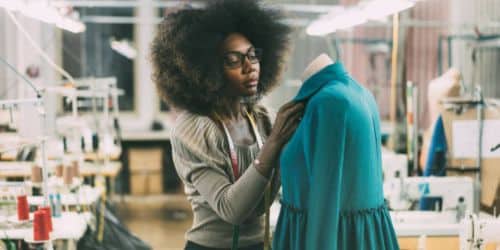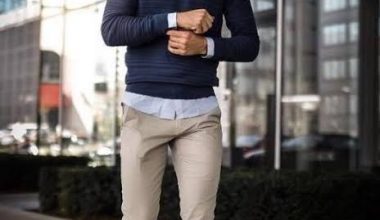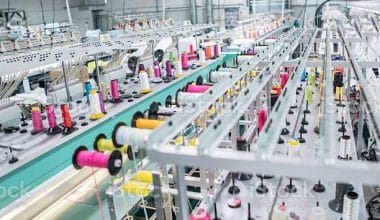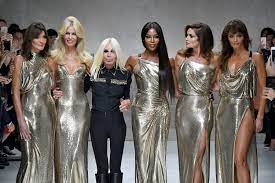Being a fashion designer can be a dream come true for people with a love of style and an eye for design. New trends and fashions appear every season, continuously changing the industry. Hence, creating clothing, accessories, and footwear for the fashion industry takes a lot of creativity.
This post will explore who a fashion designer is, the skills they need, what course they can take to become one, and famous designers in the industry.
Fashion Designer
A fashion designer develops clothing pieces for consumers, such as dresses, suits, slacks, skirts, accessories, shoes, and handbags. The individual may choose to focus on designing apparel, accessories, or jewelry, or they may be able to work in more than one of these fields.
Fashion designers draw plans for clothes, shoes, and other items. They further make unique clothes, shoes, and accessories. Also, they draw sketches, choose fabrics and patterns, and tell people how to make the things they come up with.
What Does a Fashion Designer Do?
A fashion designer works with design houses or establishes their own label. They design apparel, accessories, and other fashion accessories utilizing their creativity, understanding of current trends, and knowledge of the human body.
Also, a fashion designer can pursue a variety of specializations, including haute couture, ready-to-wear, sportswear, costume design, accessories design, bridal design, and children’s wear design.
Skills for a Fashion Designer
To become a fashion designer, you’ll need the following set of skills:
- Good communication skills
- Presentation skills
- Flexibility to change styles to fit what customers want
- Software skills related to design
- Negotiating skills
- Creative and artistic skills
- Organization
- Ability to plan ahead.
- Have an interest in fashion and new fashion trends
Roles of a Fashion Designer
The responsibilities of a fashion designer may include the following:
- Conceptualizing and sketching designs: Fashion designers sketch or CAD their ideas, considering current trends or their own perspective
- Selecting fabrics and materials: Designers choose textiles and materials based on durability, weight, texture, and cost.
- Creating prototypes: A fashion designer makes prototypes by draping fabric on a mannequin or drawing a pattern from scratch to match their design concept.
- Overseeing production: Designers work with manufacturers and other fashion professionals to ensure product quality and design.
- Fashion shows and presentations: Designers show off their new collections to the public, media, and potential purchasers to build brand awareness.
- Managing budgets and deadlines: A fashion designer must combine creativity and be commercial savvy to create a new and profitable design.
Salary of a Fashion Designer
Now that we have looked at a fashion designer’s necessary skills and roles, let’s look at the salary range of a designer.
The salary of a fashion designer varies depending on factors such as experience, location, and industry. In the United Kingdom, the national average salary for a fashion designer is £31,146 yearly. However, it can range from £20,000 to £40,000. A freelance fashion designer in the United Kingdom has an average salary of £31,872 annually.
For an entry-level fashion designer with less than 1 year of experience, the average total salary is £19,632. Whereas a fashion designer with 1-4 years of experience earns an average total salary of £25,506.
In the United States, the average salary for a fashion designer is around $77,450 per year. Wages typically start at $37,480 and go up to $130,870.
What Are the Four Main Types of Fashion Designers?
The four main types of fashion designers are:
- Haute couture and Costume designers
- Pret-a-porter designers ( Ready to wear)
- Jewelry and accessories designers.
- Shoe designers
Fashion Designer Famous
Several famous fashion designers have greatly influenced the fashion industry with their designs. They include:
- Coco Chanel: A famous revolutionary fashion designer who introduced the little black dress and made women wear pants as fashionable attire.
- Christian Dior: Famous for his tailored women’s suits and chic ready-to-wear fashions, Dior helped make Paris the world’s fashion capital.
- Alexander McQueen: A famous British fashion designer who pushed boundaries and created avant-garde designs.
- Diane von Furstenberg: Known for her wrap dress, which has become iconic in fashion.
- Ralph Lauren: A famous American fashion designer known for his classic American-style clothing and iconic polo shirts.
- Yves Saint Laurent: He started his own designer fashion house in the 1960s, becoming famous for tailored women’s suits and making chic ready-to-wear fashions available to the masses.
- Giorgio Armani: A famous Italian fashion designer known for his luxurious and opulent clothing style.
- Karl Lagerfeld: A German designer who was the creative director for Chanel and Fendi, known for his elegant and timeless designs.
- Donatella Versace: The sister of Gianni Versace, who took over the brand after her brother’s death and continued to create iconic designs.
- Roberto Cavalli: A famous Italian fashion designer known for his glamorous style, exotic prints, and flamboyant designs.
What are the 5 styles of fashion?
Various styles of fashion are trendy; they include the following:
#1. Athleisure Style
Athleisure is a new look that women love. This style mixes easy-to-wear gym clothes with clothes for a casual coffee date with friends. The most important parts are too-big pieces and styles that fit close to the body, like baggy jackets with biker shorts or technical pants with sports bras. Also, you can find fitness-inspired accessories like baseball caps and backpacks. The clothes have clean lines and simple shapes. So, to put it simply, the best athleisure outfit is the one that makes you look like you’re always moving.
#2. Street Style
Streetstyle is very popular, and there’s a good reason for that. The subcultures of skateboarders, surfers, and hip-hop artists gave rise to these fresh, modern, and generally casual clothing styles. These styles have been given a luxury makeover. Pieces that are usually worn by men, like bomber coats and work clothes, are also popular in the streetwear style world. Some try out loud, all-over colors, while others prefer more subtle tracksuits that look like they were made for sports.
#3. Business Casual
Business casual started in Silicon Valley in the early 1980s and is probably one of the most famous fashion styles. It’s pretty easy to figure out what it means. Think of it as the perfect mix of classic work clothes and more casual pieces that can be worn to the office without being too formal or polished. But that doesn’t mean you can only wear this style when you’re at work.
Your daily outfit will consist of skirts, pants, shirts, blazers, and flats or ankle boots. Also, you can pair sweaters, cardigans, and polo or knit shirts with tailored pants in neutral or dark colors.
#4.Vintage Style
The most popular style in 2022 will be vintage fashion. Most of the time, this term refers to things made between 20 and 100 years ago. Again, when it comes to retro dressing, there are no rules about what you should or shouldn’t wear. For example, flapper dresses from the 1920s, tweed skirts from the 1940s, Wayfarer sunglasses from the 1990s, and flannel shirts from the 1990s are all old.
#5. Retro Style
Most of the time, the word “retro” refers to the 20–30 years before the current decade, but most people use it to mean 40 or even 50 years before it. The return of Y2K also fits into this group. So, butterfly clips, low-rise jeans, glitter, oversized coats with padded shoulders, tie-dye t-shirts, suede jackets with fringe, and the all-too-familiar two-toned hair can all be part of a retro look.
In the end, the retro style is a varied mix of old styles and modern touches that capture the spirit of the past decades.
How Do I Start Studying Fashion?
For those who are interested in becoming successful fashion designers, obtaining a bachelor’s degree in fashion design is not required. However, if you are certain that the fashion sector is where you should be working, taking classes in fashion design can be an excellent method to acquire marketable skills such as pattern making, draping, fashion drawing, and the business side of the fashion industry.
How to Learn to Design Clothes
In the fashion world, where you went to school is usually less important than your portfolio, skills, and designs. But majoring in fashion design is a great way for a fashion designer to learn how to use design tools and meet people. Here’s what to do first.
- Find out about the fashion business. Studying is the first step to fashion school. Study fashion’s past and present concerns. Self-directed learning can help you generate ideas and get ahead in school, which can help you apply to institutions.
- Start with the basics: Learning the basics of fashion design and construction, like drawing, sewing, making patterns, and color theory, is another important way to prepare for a fashion design school.
- Draw your own pictures: Try some creative designs to see if fashion design is suited for you. Draw outfit concepts in your sketchbook and pick the ones you like that are within your skill level. Practice improves portfolios.
- Put together a resume: Before you apply to fashion school, you should make a portfolio of your work. This could include drawings of your designs or photos of your own clothesline.
- Look into places that focus on fashion design: Many design schools offer a wide range of majors and specializations in the fashion world. Coursework can be about anything related to fashion, like fashion history, computer design skills, or fashion business.
- Try things out for yourself: Many fashion schools give or require their students to intern at a fashion house. This is a great way to learn useful design skills and meet new people. If you make the most of these chances, you’ll be well on your way to becoming a fashion designer.
What Course to Take in Fashion?
Students take courses in fashion design to learn how to develop and produce clothing and accessories for themselves and others. An aspiring fashion designer can enroll in fashion design classes at either a university or an art school. They can pursue an associate’s degree, a bachelor’s degree, or a master’s degree after completing a predetermined number of classes.
Some courses you can take in fashion classes include:
#1. Visual Arts
You can learn topics linked to visual art mediums, including painting and drawing, as well as photography, by taking a class in visual arts. The majority of the time, students in these classes will combine more conventional methods with digital forms while creating visual products.
You may leverage this information to support your future branding as a fashion designer by incorporating it into your designs and using it to help build your brand. A course in visual arts can take many different forms, but some of them offer content that is useful for students seeking to be fashion designers, such as drawing and sketching. In addition, the curriculum may contain a concentration on the various enameling and rendering techniques.
#2. The History of Art
A course on the history of art can assist you in better comprehending the varied aesthetics that are prevalent in various societies and cultures. Fashion is an art form. Also, fashion designers’ creative process frequently involves drawing inspiration from various sources, one of which is history. A better understanding of art history can also provide context for the ideas and works you create. In some art history classes, students will also cover material devoted to the study of fashion history as well as other pertinent fashion issues.
#3. Tailoring
In comparison to a standard fashion design degree, a tailoring course may offer an aspiring fashion designer the opportunity to gain a more in-depth understanding of the tailoring process. Hence, students who take courses in tailoring learn how to fit clothing properly and use the knowledge they gained in pattern-making classes in their tailoring practices. You could also gain an awareness of industry tailoring standards and industrial sewing equipment and develop the skills necessary to adapt patterns and clothes to accommodate various sizes.
#4. Surface and Textile Design
Before beginning a career in fashion design, another design specialization to consider is textile and surface design. Instead of emphasizing clothes or accessories, this design course focuses on materials. Also, students learn how to create products for the fashion and interior design industries.
The course will teach you how to manipulate various materials using manual methods, like screen printing or weaving. Additionally, you learn how to plan your designs using computer tools, mimic materials or patterns, and create a portfolio.
#5. The Art of Fashion Design
You can learn about various facets of the fashion industry by taking a general course in fashion design. Taking entrepreneurship and product development classes may further allow you to learn about the history of fashion design and modern advancements made in the sector.
In certain classes, students may specialize in a particular fashion design sub-genres, such as knitwear or athletic clothing. The construction and tailoring of clothing and also the utilization of various textiles and fabrics are topics frequently covered in fashion design classes. These topics are necessary for pursuing a career in the fashion industry. You may also master other visual and digital design skills.
Fashion Designer Course Online Free
There are various online course a fashion designer can take, they include the following:
- Oxford Home Study Centre: This institution offers a new collection of online fashion design courses for free. These courses cover an extensive range of essential topics and knowledge areas, making them ideal for both newcomers and experienced fashion designers.
- International Career Institute: ICI offers a fashion design course that is prepared with the most admired names in the fashion industry. This course teaches you the ins and outs of fashion design from scratch.
- Training Tale: This institution offers a Fashion Design and Dress Making Online Training course to teach you how to create your own clothing designs and turn your fashion dreams into reality.
- Compete High: This institution offers an online Fashion Design Training course that teaches you details of fashion designing, style, dressing, pattern, and fashion designing career paths from scratch.
- Coursera: This online learning platform offers a six-week course taught by a well-known fashion designer. The course takes students through the basics of fashion design, from sketching to creating a portfolio.
- Udemy: This online learning platform offers a 12-lesson course that covers everything from color theory to fabric selection. It’s perfect for those who want a more in-depth introduction to fashion design.
- How to Sew: This free online sewing class covers everything from measuring yourself to stitching seams evenly. It’s a great option for those who want a more general introduction to designing clothes.
What Subjects Do I Need to Study Fashion?
You can study the following subjects as an aspiring fashion designer:
- Fashion journalism
- Business management
- Art and design
- Textile design
Is Being a Fashion Designer Easy?
Depending on one’s passion, creativity, and commitment to the trade, becoming a fashion designer may be both simple and difficult. It’s a really creative and gratifying job that calls for a mix of artistic talent, technological expertise, as well as financial sense. It is, nevertheless, a very competitive industry, with designers always aiming to produce products that stand out in a crowded market.
Related Articles
- Strategies for Making Your Fashion Brand Stand Out
- STARTING A CLOTHING BRAND: Simplified Step-By-Step Guide
- BUSINESS PROFESSIONAL ATTIRE: Top Attires in 2023






